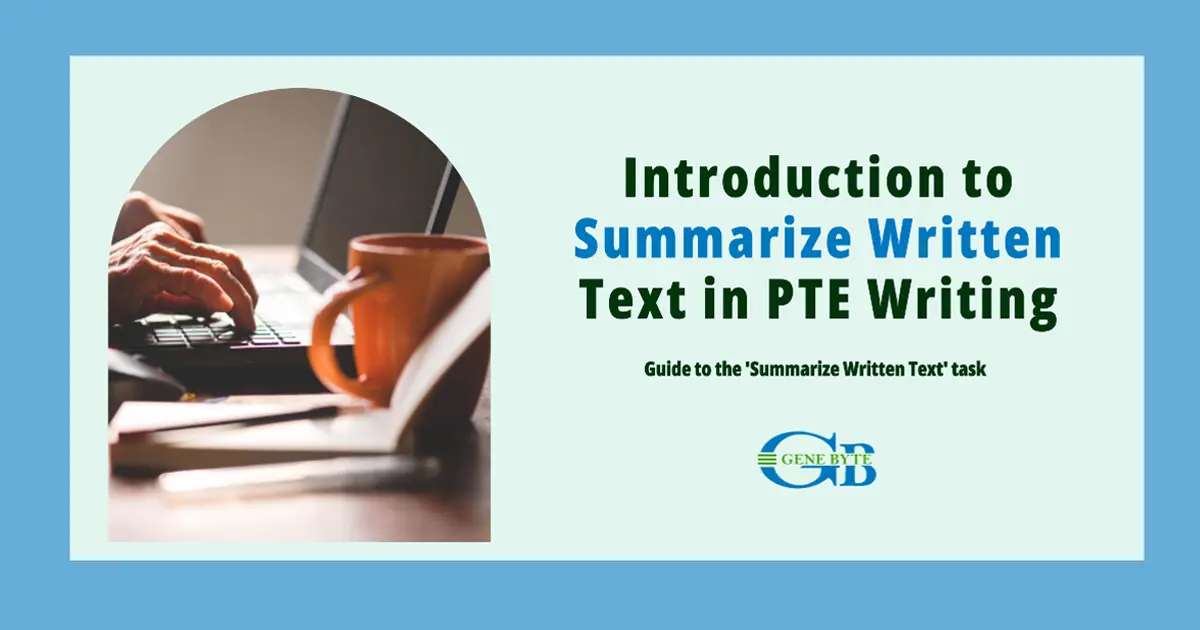Discussing PTE Summarize Written Text:
An Essential Guide for Teachers
Unlocking the Summarize Written Text Task in PTE Academic for Educators

"Mastering the art of summarization in PTE Academic isn't just about writing—it's about capturing the essence of a text in one concise, impactful sentence."
Are you, as an educator, equipped to guide your students through the Summarize Written Text task in the Writing Section of the PTE Academic exam? At Genebyte, we recognize the importance of this section in evaluating students' synthesis and expression skills.
Key Takeaways:
- Task Requirements: Students condense a passage of up to 300 words into a single, coherent sentence, testing precision, comprehension, and clarity.
- Skills Assessed: Evaluates reading and writing proficiency by capturing core ideas within a strict word limit.
- Effective Strategies: Understanding the task helps educators develop effective teaching methods aligned with its requirements.
- Innovative Solutions: Genebyte's B2B SaaS solutions provide tools and strategies to enhance teaching methods for this task.
- Empower Educators: Equip teachers with resources to improve student performance and elevate educational outcomes for coaching institutes.
Join us as we explore strategies, tips, and expert insights to refine your teaching approach for the Summarize Written Text task. Embrace the Genebyte advantage to transform your instructional methods and lead your students to PTE Academic success.

Introduction to Summarize Written Text in PTE Academic
Definition and Overview
At Genebyte, we recognize the pivotal role of the Summarize Written Text task in PTE Academic. This task challenges test-takers to distill a text of up to 300 words into a single, comprehensive sentence. It's a nuanced blend of concise writing and thorough comprehension, reflecting a student's ability to grasp and articulate the essence of a passage succinctly.
Importance in PTE Academic
The significance of this task lies in its dual focus on reading and writing skills, making it a critical component of the PTE Academic exam. It tests a student's ability to identify key ideas and express them in a limited word count, a skill paramount in academic and professional environments. This task not only assesses the student's understanding of the text but also their ability to convey complex ideas efficiently.
Skills Assessed: Reading and Writing
The Summarize Written Text task is designed to evaluate two core skills:
-
Reading Comprehension:
- Identifying the main idea and supporting details
- Understanding the author's purpose and tone
- Analyzing the structure and argument of the text
-
Concise Writing:
- Crafting a clear, coherent summary in a single sentence
- Demonstrating grammatical accuracy and a rich vocabulary
- Adhering to strict word limits without losing essential information

Task Description and Requirements for Summarize Written Text in PTE Academic
Task Explanation: Summarizing a Text in One Sentence
Summarize Written Text is the first Writing task after Speaking's Answer Short Question, where students have to fulfil a unique and challenging requirement: condensing a text of up to 300 words into one comprehensive sentence! This exercise tests the ability to distill complex information and express it concisely, a skill that is increasingly valuable in both academic and professional contexts.
Prompt Length: Up to 300 Words
Each text presented in this section ranges up to 300 words. This length is carefully chosen to provide a detailed context while ensuring it is manageable within the time constraints. It allows students to engage with a variety of topics, ensuring they develop the ability to summarize across different subjects and styles.
Time Allocation: 10 Minutes
Students are allotted 10 minutes for this task. This time frame is designed to test not only their summarization skills but also their ability to manage time effectively. Within these 10 minutes, students must read, comprehend, and then concisely summarize the text, showcasing their proficiency in both reading and writing under time pressure.
Scoring Criteria Overview
The scoring for Summarize Written Text is based on several key factors:
- Content: The summary must encapsulate the main points of the text without misrepresenting the topic or purpose.
- Form: The response should be a single, complete sentence within the word limit (5 to 75 words).
- Grammar: It evaluates the grammatical accuracy of the sentence structure.
- Vocabulary: The choice of words should be appropriate and relevant, demonstrating an understanding of the passage and effective use of synonyms.
Genebyte's Role in Enhancing Student Performance
Genebyte's B2B SaaS solutions offer a structured approach to mastering this task. Our platform includes:
- Interactive Practice Sessions: Tools that simulate real exam conditions, helping students hone their summarization skills.
- Custom Feedback Mechanisms: Providing detailed analysis of students' responses, focusing on areas like content relevance, sentence structure, and vocabulary usage.
- Educator Support: Comprehensive resources and guidelines for educators to effectively teach and guide students in mastering this challenging task.

The Role of Summarize Written Text in PTE Academic Scoring
Contribution to Reading and Writing Scores
The Summarize Written Text task in PTE Academic is not just a test of students' language skills but a significant contributor to their overall reading and writing scores. This task uniquely bridges the two skills, requiring students to read and comprehend a passage before condensing its essence into a single, coherent sentence. Like in RWFIB, this synthesis of Writing and Reading skill underlines the task's importance in the PTE Academic scoring system.
Understanding the Scoring Mechanism
The scoring for Summarize Written Text revolves around four critical components:
- Content Accuracy: Ensuring the summary captures all relevant points without distorting the text's purpose.
- Adherence to Form: The response must be a single, complete sentence, adhering to the prescribed word limit (between 5 to 75 words).
- Grammatical Precision: Evaluating the grammatical correctness of the sentence structure.
- Vocabulary Appropriateness: Assessing the relevance and variety of vocabulary used, including the effective use of synonyms.
Importance of Content, Form, Grammar, and Vocabulary
In Summarize Written Text, each aspect plays a vital role:
- Content: It's about extracting and conveying the main ideas without altering the original meaning.
- Form: The challenge lies in maintaining the summary within a single sentence, making every word count.
- Grammar: This reflects the student's ability to construct grammatically sound sentences.
- Vocabulary: A varied and appropriate vocabulary demonstrates a deep understanding of the text and its context.

Templates and Tricks in Summarize Written Text - A Balanced Approach
Templates and Tricks: Are They Beneficial?
In the context of PTE Academic's Summarize Written Text, the use of templates and tricks is a subject of debate. While these tools can provide a structured approach for students, understanding their benefits and drawbacks is crucial for educators.
Pros and Cons of Using Templates and Tricks
-
Pros:
- Structure and Confidence: Templates offer a clear structure, which can be particularly helpful for students who struggle with organizing their thoughts.
- Time Efficiency: They can speed up the response process, ensuring that students utilize the allocated 10 minutes effectively.
-
Cons:
- Lack of Originality: Over-reliance on templates can lead to repetitive and formulaic summaries that lack personal insight.
- Limited Flexibility: Templates may not suit every text type, potentially leading students to force-fit irrelevant structures.
Encouraging Authentic Student Responses
At Genebyte, we believe in nurturing authentic and thoughtful responses. Our approach encourages students to:
- Understand the Core Idea: Focus on grasping the main theme of the text rather than mechanically applying a template.
- Develop Personal Style: Encourage students to express their understanding in a way that reflects their unique voice and comprehension.
Strategies for Avoiding Over-reliance on Templates
To prevent students from becoming dependent on templates, Genebyte's solutions include:
- Diverse Practice Materials: Offering a range of texts that challenge students to apply different summarization techniques.
- Feedback Mechanisms: Providing personalized feedback that highlights the importance of originality and content relevance over rigid structures.

Challenges Faced by Students in Summarize Written Text
Common Difficulties in Summarizing Texts
In the Summarize Written Text task of PTE Academic, students often encounter several challenges:
- Identifying Core Ideas: Distilling the main points from a text of up to 300 words can be daunting, especially under time pressure.
- Avoiding Detail Overload: Students struggle to differentiate between essential ideas and secondary details, often leading to cluttered summaries.
- Maintaining Text Integrity: There's a fine line between summarizing and altering the original meaning, which students often find challenging to navigate.
Balancing Brevity and Comprehensiveness
This task requires a delicate balance:
- Brevity: Summaries must be concise, fitting into a single sentence of 5 to 75 words.
- Comprehensiveness: Despite the brevity, summaries must encapsulate all crucial points of the passage.
Time Management Strategies
Effective time management is crucial:
- Initial Reading (2-3 minutes): Quick reading to grasp the overall theme and key points.
- Drafting Summary (5-6 minutes): Focusing on writing a coherent, comprehensive sentence.
- Review and Refinement (1-2 minutes): Checking for grammar, word count, and relevance.

Regular Techniques from Educator's Perspective in Summarize Written Text
Teaching Techniques for Effective Summarization
In the realm of PTE Academic's 'Summarize Written Text,' educators play a crucial role in guiding students. Genebyte's insights reveal several effective teaching techniques:
- Guided Practice Sessions: Start with guided exercises where educators highlight key elements in texts and demonstrate how to condense them.
- Interactive Discussions: Engage students in discussions about the text to enhance comprehension and identify main points collaboratively.
- Model Summaries: Provide examples of effective summaries, analyzing their structure and content.
Focusing on Key Ideas and Supporting Details
Educators should emphasize:
- Identifying Main Points: Teach students to pinpoint the central idea of the text.
- Differentiating Between Primary and Secondary Information: Help students recognize and focus on the most critical elements of the text.
- Integration of Details: Show how supporting details can be woven into the summary without overcrowding it.
Encouraging Critical Reading and Concise Writing
Critical to mastering Summarize Written Text is the development of two key skills:
-
Critical Reading:
- Analyzing Text Structure: Guide students in understanding how texts are organized.
- Interpreting Author's Intent: Teach students to discern the underlying purpose and tone of the text.
-
Concise Writing:
- Practicing Brevity: Encourage students to express ideas in a succinct yet complete manner.
- Refining Language Skills: Focus on improving grammar and vocabulary for clear and effective writing.

Special Techniques from Educator's Perspective in Summarize Written Text
Focusing on Tricks
In teaching the Summarize Written Text component of PTE Academic, educators often employ various tricks to enhance students' performance. These tricks are designed to help students effectively identify key points and convey them succinctly.
- Highlighting Key Sentences: Educators teach students to identify and highlight sentences in the passage that encapsulate the main idea or essential information.
- Note-Taking Strategies: Developing effective note-taking skills that enable students to jot down important points quickly and accurately.
Using FANBOYS
FANBOYS (For, And, Nor, But, Or, Yet, So) are conjunctions that can be particularly useful in crafting summaries:
- For Complex Sentences: They help in connecting independent clauses, thereby facilitating the creation of complex sentences that are essential in summarization.
- Balancing Ideas: These conjunctions aid in maintaining a balance between brevity and comprehensiveness, allowing students to link main ideas with supporting details effectively.

Genebyte's Solutions for Teaching Summarize Written Text
Utilizing Genebyte's Solution in Teaching Summarization
Genebyte's innovative B2B SaaS solutions are specifically designed to address the challenges educators face in teaching the Summarize Written Text task in PTE Academic. Our platform offers:
- Comprehensive Practice Tools: Interactive exercises that simulate the PTE Academic environment, providing students with real-life summarization challenges.
- Adaptive Learning Techniques: Tailored learning paths that cater to individual student needs, focusing on areas like key idea identification and concise writing skills.
Benefits of Genebyte's Resources for Educators
Genebyte's platform provides educators with:
- In-depth Analytical Tools: These tools offer insights into students' performance, helping educators to identify areas for improvement and tailor their teaching strategies accordingly.
- Resource Diversity: A vast library of practice materials, including texts of varying lengths and complexities, ensures comprehensive training in summarization skills.
Enhancing Student Engagement and Understanding
Our approach focuses on:
- Engagement through Technology: Interactive tools that make learning more engaging and effective for students.
- Understanding through Practice: Regular practice sessions that enhance students' ability to understand and summarize texts, building their confidence and skill set.
Real-Life Application: A Case Study
Suman Dahal, an educator in the Rise Coaching Center, noticed a significant improvement in students' summarization skills after using Genebyte's platform. The platform's tailored practice sessions along with detailed analytics helped identify students struggling with identifying main ideas.

Actionable Recommendations for Educators
- Focus on Key Ideas: Teach students to identify the central theme and supporting details in diverse reading materials.
- Balance Brevity with Detail: Train students to express comprehensive ideas in a single, concise sentence.
- Time Management: Implement timed practice sessions to help students effectively manage the 10-minute window for reading, drafting, and reviewing.
- Advanced Analytical Tools: Get detailed insights into student performance to build and build tailored strategies.
- Interactive Learning Materials: Offer engaging resources to enhance summarization abilities.
Summarizing in the PTE Academic Summarize Written Text task requires critical reading, concise writing, and effective time management. These skills also prepare students for the upcoming task, the Write Essay task. and mirrors the demands of academic and professional communication.
Transform Your Teaching Approach with Genebyte
Explore Genebyte's innovative solutions to revolutionize your PTE Academic preparation. Contact us for more information and enhance your teaching methodologies today.
Frequently Asked Questions
No, copy-pasting is not allowed. Students must summarize the text in their own words, demonstrating comprehension and summarization skills.
Focus on identifying the main idea and supporting details. Craft a single, coherent sentence that encapsulates the essence of the text while maintaining brevity.
The summary should be a single sentence, typically between 5 to 75 words, to effectively capture the main points of the text.
Yes, semicolons can be used to connect independent clauses in a sentence, aiding in creating a concise and comprehensive summary.
Connectors like 'however,' 'therefore,' and 'moreover' can be useful. They help in linking ideas cohesively within the summary.
It's a task where students read a passage and write a one-sentence summary, testing their reading comprehension and concise writing skills.
Recent trends emphasize clarity, precision, and the use of diverse vocabulary while summarizing.
Students are given 10 minutes to read the text and summarize it, requiring effective time management.
Scoring is based on content accuracy, form, grammatical correctness, and vocabulary use.
Techniques include identifying key ideas, using effective connectors, and practicing concise writing.
There are various AI tools available that mimic PTE scoring, providing practice and feedback for improvement.
Typically, one or two Summarize Written Text tasks appear in the PTE Academic exam.
Focus on the main idea, adhere to the word limit, and ensure grammatical accuracy.
While templates can provide structure, over-reliance on them can hinder the development of authentic summarization skills.
Yes, strategies like understanding the text structure and practicing time management are beneficial.
Encourage critical reading, practice with diverse texts, and focus on summarizing skills in a time-bound manner.